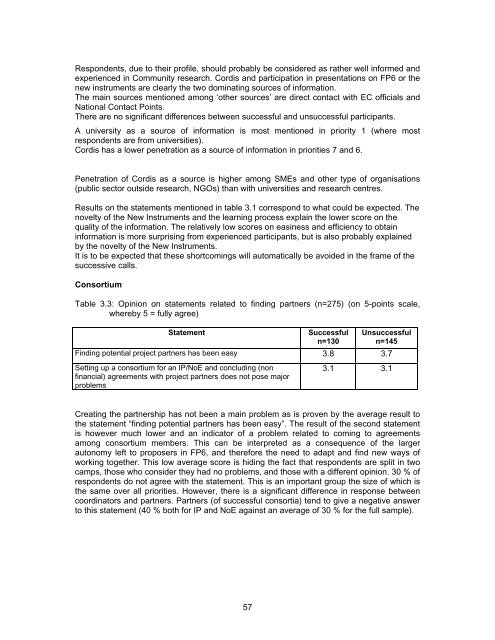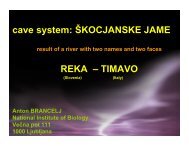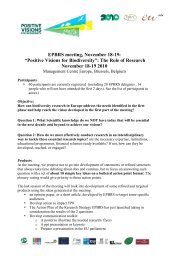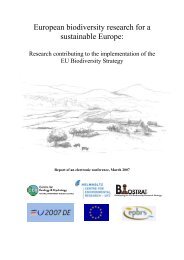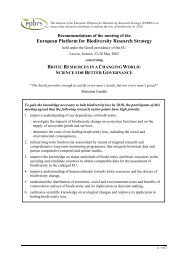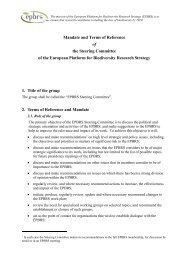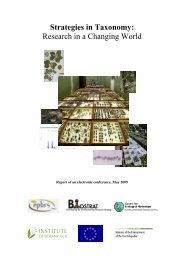Evaluation of the effectiveness of the New Instruments of ... - CORDIS
Evaluation of the effectiveness of the New Instruments of ... - CORDIS
Evaluation of the effectiveness of the New Instruments of ... - CORDIS
You also want an ePaper? Increase the reach of your titles
YUMPU automatically turns print PDFs into web optimized ePapers that Google loves.
Respondents, due to <strong>the</strong>ir pr<strong>of</strong>ile, should probably be considered as ra<strong>the</strong>r well informed and<br />
experienced in Community research. Cordis and participation in presentations on FP6 or <strong>the</strong><br />
new instruments are clearly <strong>the</strong> two dominating sources <strong>of</strong> information.<br />
The main sources mentioned among ‘o<strong>the</strong>r sources’ are direct contact with EC <strong>of</strong>ficials and<br />
National Contact Points.<br />
There are no significant differences between successful and unsuccessful participants.<br />
A university as a source <strong>of</strong> information is most mentioned in priority 1 (where most<br />
respondents are from universities).<br />
Cordis has a lower penetration as a source <strong>of</strong> information in priorities 7 and 6.<br />
Penetration <strong>of</strong> Cordis as a source is higher among SMEs and o<strong>the</strong>r type <strong>of</strong> organisations<br />
(public sector outside research, NGOs) than with universities and research centres.<br />
Results on <strong>the</strong> statements mentioned in table 3.1 correspond to what could be expected. The<br />
novelty <strong>of</strong> <strong>the</strong> <strong>New</strong> <strong>Instruments</strong> and <strong>the</strong> learning process explain <strong>the</strong> lower score on <strong>the</strong><br />
quality <strong>of</strong> <strong>the</strong> information. The relatively low scores on easiness and efficiency to obtain<br />
information is more surprising from experienced participants, but is also probably explained<br />
by <strong>the</strong> novelty <strong>of</strong> <strong>the</strong> <strong>New</strong> <strong>Instruments</strong>.<br />
It is to be expected that <strong>the</strong>se shortcomings will automatically be avoided in <strong>the</strong> frame <strong>of</strong> <strong>the</strong><br />
successive calls.<br />
Consortium<br />
Table 3.3: Opinion on statements related to finding partners (n=275) (on 5-points scale,<br />
whereby 5 = fully agree)<br />
Statement<br />
Successful<br />
n=130<br />
Unsuccessful<br />
n=145<br />
Finding potential project partners has been easy 3.8 3.7<br />
Setting up a consortium for an IP/NoE and concluding (non<br />
financial) agreements with project partners does not pose major<br />
problems<br />
3.1 3.1<br />
Creating <strong>the</strong> partnership has not been a main problem as is proven by <strong>the</strong> average result to<br />
<strong>the</strong> statement “finding potential partners has been easy”. The result <strong>of</strong> <strong>the</strong> second statement<br />
is however much lower and an indicator <strong>of</strong> a problem related to coming to agreements<br />
among consortium members. This can be interpreted as a consequence <strong>of</strong> <strong>the</strong> larger<br />
autonomy left to proposers in FP6, and <strong>the</strong>refore <strong>the</strong> need to adapt and find new ways <strong>of</strong><br />
working toge<strong>the</strong>r. This low average score is hiding <strong>the</strong> fact that respondents are split in two<br />
camps, those who consider <strong>the</strong>y had no problems, and those with a different opinion. 30 % <strong>of</strong><br />
respondents do not agree with <strong>the</strong> statement. This is an important group <strong>the</strong> size <strong>of</strong> which is<br />
<strong>the</strong> same over all priorities. However, <strong>the</strong>re is a significant difference in response between<br />
coordinators and partners. Partners (<strong>of</strong> successful consortia) tend to give a negative answer<br />
to this statement (40 % both for IP and NoE against an average <strong>of</strong> 30 % for <strong>the</strong> full sample).<br />
57


